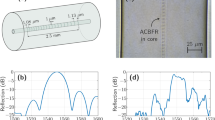Abstract
Ultra-narrow linewidth laser with several hundred hertz at room temperature has attracted a great deal of attention in recent years and played a critical role in both optical sensing and communication fields. In this paper, a new method based on Rayleigh backscattering to highly compress the laser linewidth was proposed and demonstrated theoretically and experimentally. By theoretical analysis and simulation, Rayleigh backscattering can be collected in any waveguide structure and all wave bands, which could have a revolutionary impact on the field of laser. A single-longitudinal mode fiber ring laser with 130-Hz linewidth was achieved with self-injection feedback structure at normal atmospheric temperature. The linewidth compression based on Rayleigh backscattering lies in the fact that laser linewidth after scattering is narrower than that of incident light in high Rayleigh scattering structure. The self-rejection feedback method expanding free spectra range of laser cavity simultaneously was used to further suppress the mode-hopping and stabilizing output. Experimental results showed that the laser linewidth can be easily narrowed to hundreds of hertz with side-mode suppression up to 75 dB. This agrees with the theoretical analysis and simulation results qualitatively.
摘要
频率线宽低至数百赫兹的超窄激光器具有极低的频率噪声和超长的相干长度, 在光原子钟、引力波探测、低噪声微波信号产生、高精度激光测距以及光纤传感等领域有重要的应用. 论文首次提出了基于后向瑞利散射的激光线宽压缩模型, 实验中利用瑞利散射机制和自注入反馈结构得到了线宽低至130 Hz, 边摸抑制比高达75 dB的超窄线宽激光输出. 基于后向瑞利散射能够对任意波段的单波长或多波长激光线宽产生压缩效果, 并且通过制作和优化产生瑞利散射的波导结构, 能实现常温常态下工作的便携式超窄线宽激光装置.







Similar content being viewed by others
References
Spiegelberg C, Geng JH, Hu YD et al (2004) Low-noise narrow-linewidth fiber laser at 1550 nm. J Lightwave Technol 22:57–62
Kurtz J (1993) Coherent radar performance estimation. Artech House, Boston
Fortier TM, Kirchner MS, Quinlan F et al (2011) Generation of ultra-stable microwaves via optical frequency division. Nat Photonics 5:425–429
Shen YH, Qin YQ, Wu B et al (2009) Short cavity single frequency fiber laser for in situ sensing applications over a wide temperature range. Opt Express 15:363–370
Horowitz M, Daisy R, Fischer B et al (1994) Narrow-linewidth, single-mode erbium-doped fibre laser with intra cavity wave mixing in saturable absorber. Electron Lett 30:648–649
Cheng Y, Kringlebotn JT, Loh WH et al (1995) Stable single-frequency traveling-wave fibre loop laser with integral saturable-absorber-based tracking narrow-band filter. Opt Lett 20:875–877
Meng Z, Stewart G, Whitenett G (2006) Stable single-mode operation of a narrow-linewidth, linearly polarized, erbium-fiber ring laser using a saturable absorber. J Lightwave Technol 24:2179–2183
Xu SH, Yang ZM, Zhang WN et al (2011) 400 mW ultra-short cavity low-noise single-frequency Yb3+-doped phosphate fiber laser. Opt Lett 36:3708–3710
Zyskind JL, Mizrahi V, DiGiovanni DJ (1992) Short single frequency Erbium-doped fibre laser. Electron Lett 28:1385–1387
Sprenger B, Schwefel HGL, Wang LJ (2009) Whispering-gallery-mode-resonator-stabilized narrow-linewidth fiber loop laser. Opt Lett 34:3370–3372
Yin FF, Yang SG, Chen HW et al (2011) 60-nm-wide tunable single-longitudinal-mode ytterbium fiber laser with passive multiple-ring cavity. IEEE Photon Technol Lett 32:1658–1660
Spirin VV, López-Mercado CA, Mégret P et al (2012) Single-mode Brillouin fiber laser passively stabilized at resonance frequency with self-injection locked pump laser. Laser Phys Lett 9:377–380
Kessler T, Hagemann C, Grebing C et al (2012) A sub-40 mHz-linewidth laser based on a silicon single-crystal optical cavity. Nat Photonics 6:687–692
Zhu T, Bao XY, Chen LA et al (2010) Experimental study on stimulated Rayleigh scattering in optical fibers. Opt Express 18:22958–22963
Agrawal GP (1995) Nonlinear fiber optics. Academic, California
Heinz TF (2008) Rayleigh scattering spectroscopy. Carbon Nanotubes. Springer, Berlin, pp 353–369
Saxena B, Bao XY, Chen L (2014) Suppression of thermal frequency noise in erbium-doped fiber random lasers. Opt Lett 39:1038–1041
Zhu T, Chen FY, Huang SH et al (2013) An ultra-narrow linewidth fiber ring laser based on Rayleigh backscattering in a tapered optical fiber. Laser Phys Lett 10:055110
Derickson D (1998) Fiber optic test and measurement. Prentice-Hall, Englewood Cliffs
Okusaga O, Cahill J, Docherty A et al (2012) Guided entropy mode Rayleigh scattering in optical fibers. Opt Lett 37:683–685
Acknowledgments
This work was supported by the National Natural Science Foundation of China (61377066), and the Fundamental Research Funds for the Central Universities (CDJZR12125502, 106112013CDJZR120002, and 106112013CDJZR160006).
Author information
Authors and Affiliations
Corresponding author
About this article
Cite this article
Zhu, T., Huang, S., Shi, L. et al. Rayleigh backscattering: a method to highly compress laser linewidth. Chin. Sci. Bull. 59, 4631–4636 (2014). https://doi.org/10.1007/s11434-014-0603-0
Received:
Accepted:
Published:
Issue Date:
DOI: https://doi.org/10.1007/s11434-014-0603-0




